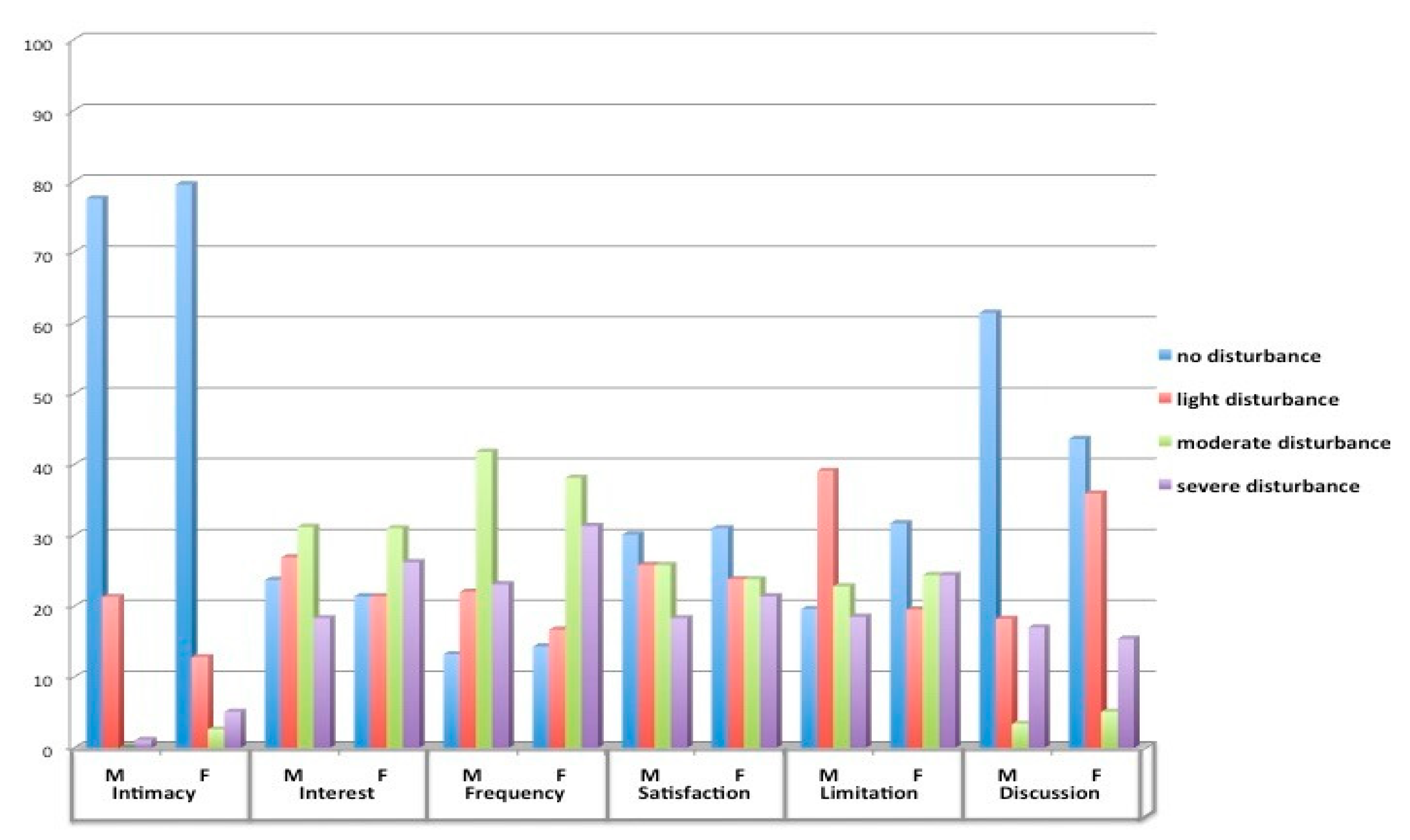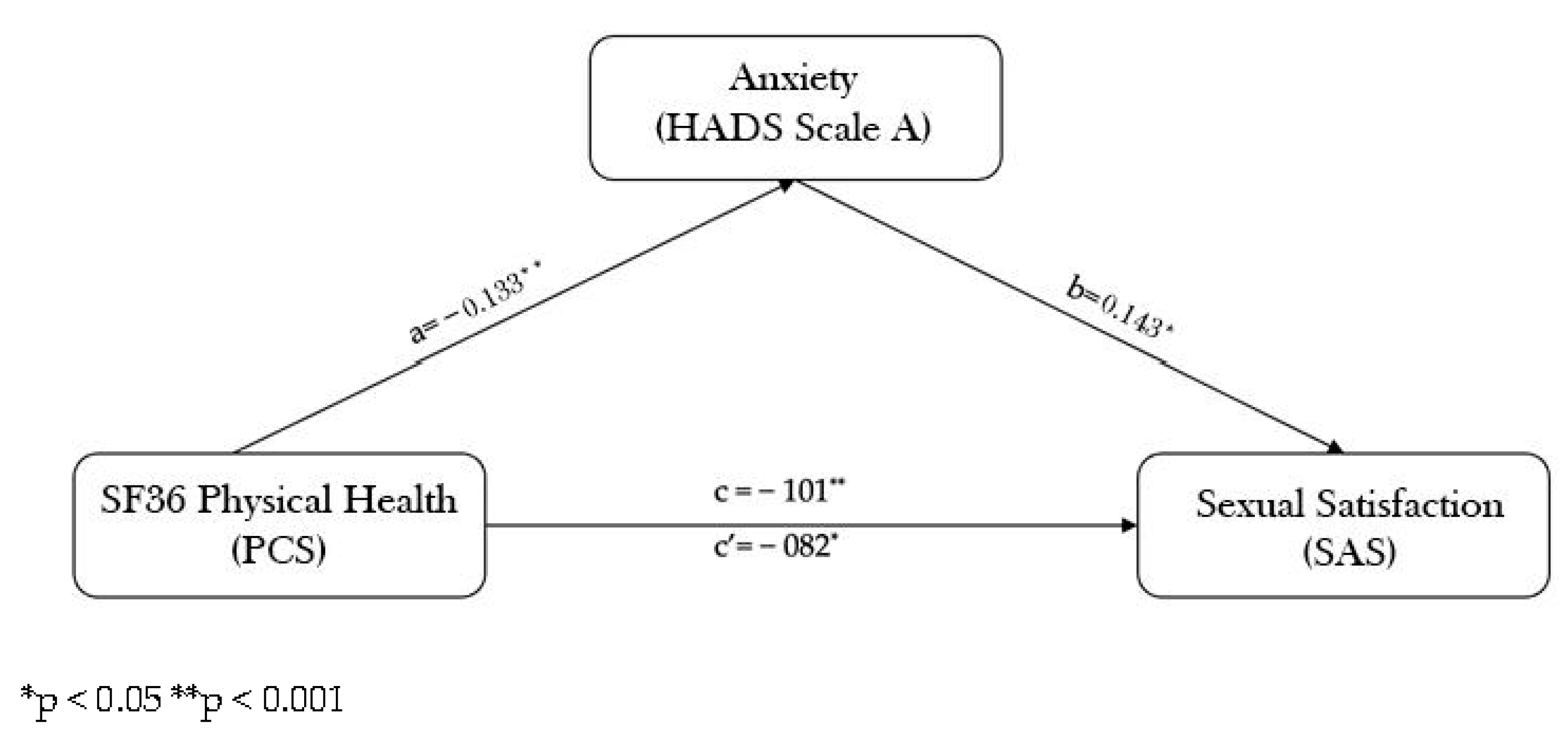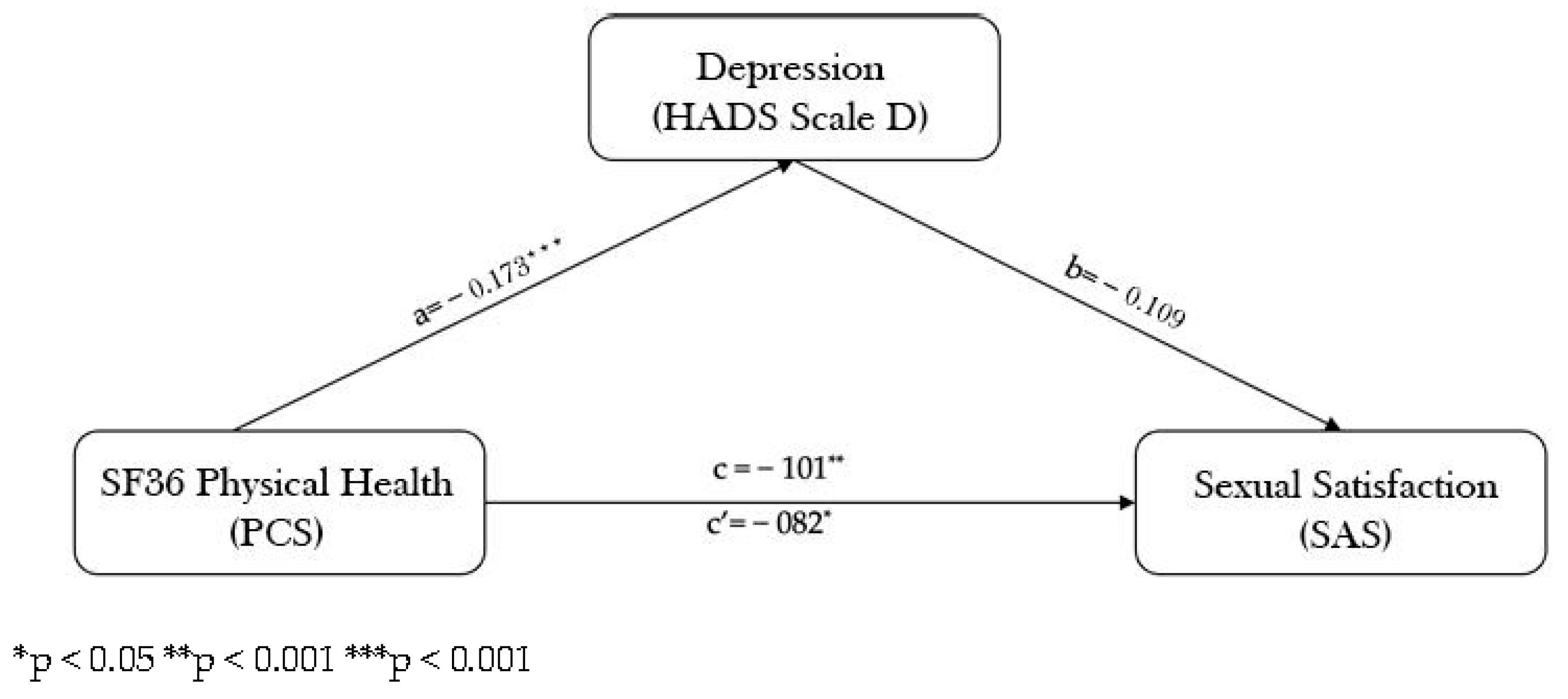Sexual Satisfaction and Quality of Life in Cardiovascular Patients: The Mediating Role of Anxiety
Abstract
1. Introduction
2. Materials and Methods
2.1. Patients
2.2. Measures
2.3. Data Analyses
3. Results
Mediation Analysis
4. Discussion
Limitations
5. Conclusions
Author Contributions
Funding
Institutional Review Board Statement
Informed Consent Statement
Data Availability Statement
Acknowledgments
Conflicts of Interest
References
- Timmis, A.; Townsend, N.; Gale, C.P.; Torbica, A.; Lettino, M.; Petersen, S.E.; Mossialos, E.A.; Maggioni, A.P.; Kazakiewicz, D.; May, H.T.; et al. European Society of Cardiology: Cardiovascular disease statistics 2019. Eur. Heart J. 2020, 41, 12–85. [Google Scholar] [CrossRef] [PubMed]
- Levine, G.N.; Steinke, E.E.; Bakaeen, F.G.; Bozkurt, B.; Cheitlin, M.D.; Conti, J.B.; Jaarsma, T.; Kloner, R.A.; Lange, R.A.; Lindau, S.T.; et al. Sexual activity and cardiovascular disease: A scientific statement from the American Heart Association. Circulation 2012, 125, 1058–1072. [Google Scholar] [CrossRef] [PubMed]
- Beerepoot, S.; Luesken, S.W.; Huisman, M.; Deeg, D.J. Enjoyment of Sexuality and Longevity in Late Midlife and Older Adults: The Longitudinal Ageing Study Amsterdam. J. Appl. Gerontol. 2022, 41, 1615–1624. [Google Scholar] [CrossRef] [PubMed]
- Jackson, S.E.; Yang, L.; Koyanagi, A.; Stubbs, B.; Veronese, N.; Smith, L. Declines in sexual activity and function predict incident health problems in older adults: Prospective findings from the English longitudinal study of ageing. Arch. Sex. Behav. 2020, 49, 929–940. [Google Scholar] [CrossRef]
- Træen, B.; Carvalheira, A.; Kvalem, I.L.; Stulhofer, A.; Janssen, E.; Graham, C.A.; Hald, G.M.; Enzlin, P. Sexuality in Older Adults (65+) An Overview of The Recent Literature, Part 2: Body Image and Sexual Satisfaction. Int. J. Sex Health 2016, 29, 11–21. [Google Scholar] [CrossRef]
- Mosack, V.; Hill, T.J.; Steinke, E.E. Predictors of change in sexual activity after cardiac diagnosis: Elements to inform sexual counseling. J. Health Psychol. 2015, 22, 925–931. [Google Scholar] [CrossRef]
- Bohdana, B.; Vrublová, Y. The effect of antihypertensive therapy on human sexuality. Cent. Eur. J. Nurs. 2014, 6, 237–244. [Google Scholar]
- Flynn, T.J.; Gow, A.J. Examining associations between sexual behaviours and quality of life in older adults. Age Ageing 2015, 44, 823–828. [Google Scholar] [CrossRef]
- Lange, R.A.; Levine, G.N. Sexual activity and ischemic heart disease. Curr. Cardiol. Rep. 2014, 16, 445. [Google Scholar] [CrossRef]
- Hoekstra, T.; Lesman-Leegte, I.; Luttik, M.L.; Sanderman, R.; van Veldhuisen, D.J.; Jaarsma, T. Sexual problems in elderly male and female patients with heart failure. Heart 2012, 98, 1647–1652. [Google Scholar] [CrossRef]
- Steinke, E.E.; Jaarsma, T.; Barnason, S.A.; Byrne, M.; Doherty, S.; Dougherty, C.M.; Fridlund, B.; Kautz, D.D.; Martesson, J.; Mosack, V.; et al. Sexual counseling for individuals with cardiovascular disease and their partners: A consensus document from the American Heart Association and the ESC Council on Cardiovascular Nursing and Allied Professions (CCNAP). Circulation 2013, 128, 2075–2096. [Google Scholar] [CrossRef] [PubMed]
- Liu, H.; Waite, L.J.; Shen, S.; Wang, D.H. Is Sex Good for Your Health? A National Study on Partnered Sexuality and Cardiovascular Risk among Older Men and Women. J. Health Soc. Behav. 2016, 57, 276–296. [Google Scholar] [CrossRef] [PubMed]
- Timonet-Andreu, E.; Morales-Asencio, J.M.; Gutierrez, P.A.; Alvarez, C.C.; Moyano, G.L.; Banderas, A.M.; Lopez-Leiva, I.; Canca-Sanchez, J.C. Health-Related Quality of Life and Use of Hospital Services by Patients with Heart Failure and Their Family Caregivers: A Multicenter Case-Control Study. J. Nurs. Scholarsh. 2020, 52, 217–228. [Google Scholar] [CrossRef] [PubMed]
- Steinke, E.; Jaarsma, T. Sexual counseling and cardiovascular disease: Practical approaches. Asian J. Androl. 2015, 17, 32. [Google Scholar] [CrossRef] [PubMed]
- Strik, J.J.; Denollet, J.; Lousberg, R.; Honig, A. Comparing symptoms of depression and anxiety as predictors of cardiac events and increased health care consumption after myocardial infarction. J. Am. Coll. Cardiol. 2003, 42, 1801–1807. [Google Scholar] [CrossRef] [PubMed]
- Mei, S.; Qin, Z.; Yang, Y.; Gao, T.; Ren, H.; Hu, Y.; Cao, R.; Liang, L.; Li, C.; Tong, Q. Influence of Life Satisfaction on Quality of Life: Mediating Roles of Depression and Anxiety Among Cardiovascular Disease Patients. Clin. Nurs. Res. 2021, 30, 215–224. [Google Scholar] [CrossRef]
- Lu, Y.; Yun, J.; Liang, G. Using path analysis to investigate the relationships between depression, anxiety, and health-related quality of life among patients with coronary artery disease. Qual. Life Res. 2019, 28, 2695–2704. [Google Scholar] [CrossRef]
- Baert, A.; Pardaens, S.; De Smedt, D.; Puddu, P.E.; Ciancarelli, M.C.; Dawodu, A.; De Sutter, J.; De Bacquer, D.; Clays, E. Sexual Activity in Heart Failure Patients: Information Needs and Association with Health-Related Quality of Life. Int. J. Environ. Res. Public Health 2019, 16, 1570. [Google Scholar] [CrossRef]
- Assari, S. Depression mediates the effect of sexual function on quality of life among men but not women with coronary artery disease. Int. Cardiovasc. Res. J. 2014, 8, 171–177. [Google Scholar]
- Kriston, L.; Günzler, C.; Agyemang, A.; Bengel, J.; Berner, M.M. Effect of Sexual Function on Health-Related Quality of Life Mediated by Depressive Symptoms in Cardiac Rehabilitation. Findings of the SPARK Project in 493 Patients. J. Sex Med. 2010, 7, 2044–2055. [Google Scholar] [CrossRef]
- Lawson, C.A.; Trapala, I.S.; Dahlstrom, U.; Mamas, M.; Jaarsma, T.; Kadam, U.T.; Stromberg, A. Comorbidity health pathways in heart failure patients: A sequences-of-regressions analysis using cross-sectional data from 10,575 patients in the Swedish Heart Failure Registry. PLoS Med. 2018, 15, e1002540. [Google Scholar] [CrossRef] [PubMed]
- Reese, J.B.; Shelby, R.A.; Taylor, K.L. Sexual quality of life in patients undergoing coronary artery bypass graft surgery. Psychol. Health 2012, 27, 721–736. [Google Scholar] [CrossRef] [PubMed]
- McCall-Hosenfeld, J.S.; Freund, K.M.; Legault, C.; Jaramillo, S.A.; Cochrane, B.B.; Manson, J.E.; Wenger, N.K.; Eaton, C.B.; McNeeley, G.; Rodriguez, B.L.; et al. Sexual satisfaction and cardiovascular disease: The Women’s Health Initiative. Am. J. Med. 2008, 121, 295–301. [Google Scholar] [CrossRef] [PubMed]
- del Mar Sánchez-Fuentes, M.; Santos-Iglesias, P.; Sierra, J.C. A systematic review of sexual satisfaction. Int. J. Clin. Health Psychol. 2014, 14, 67–75. [Google Scholar] [CrossRef]
- Derogatis, L.R. The psychosocial adjustment to illness scale (PAIS). J. Psychosom. Res. 1986, 30, 77–91. [Google Scholar] [CrossRef] [PubMed]
- Apolone, G.; Mosconi, P. The Italian SF-36 Health Survey. J. Clin. Epidemiol. 1998, 51, 1025–1036. [Google Scholar] [CrossRef]
- Costantini, M.; Musso, M.; Viterbori, P.; Bonci, F.; Del Mastro, L.; Garrone, O.; Venturini, M.; Morasso, G. Detecting psychological distress in cancer patients: Validity of the Italian version of the Hospital Anxiety and Depression Scale. Support. Cancer Ther. 1999, 7, 121–127. [Google Scholar] [CrossRef]
- Hayes, A.F. Introduction to Mediation, Moderation, and Conditional Process Analysis: A Regression-Based Approach; Guilford Publications: New York, NY, USA, 2017. [Google Scholar]
- Preacher, K.J.; Hayes, A.F. Asymptotic and resampling strategies for assessing and comparing indirect effects in multiple mediator models. Behav. Res. Methods. 2008, 40, 879–891. [Google Scholar] [CrossRef]
- Preacher, K.J.; Ken, K. Effect size measures for mediation models: Quantitative strategies for communicating indirect effects. Psychol. Methods 2011, 16, 93. [Google Scholar] [CrossRef]
- Lindau, S.T.; Schumm, L.P.; Laumann, E.O.; Levinson, W.; O’Muircheartaigh, C.A.; Waite, L.J. A study of sexuality and health among older adults in the United States. N. Engl. J. Med. 2007, 357, 762–774. [Google Scholar] [CrossRef]
- Dunne, E.M.; Senn, T.E.; Carey, K.B. Factors related to life satisfaction among urban African American adults receiving care at a publicly-funded sexual health clinic. Psychol. Health Med. 2018, 23, 360–368. [Google Scholar] [CrossRef] [PubMed]
- Moon, S.H.; Yang, H.J.; Yoon, H.J. Psychosocial Factors Influencing Anxiety Symptoms in Patients With Hypertension. Anxiety Mood 2022, 18, 17–25. [Google Scholar] [CrossRef]
- Hsu, N.W.; Tsao, H.M.; Chen, H.C.; Chou, P. Anxiety and depression mediate the health-related quality of life differently in patients with cardiovascular disease and stroke–preliminary report of the Yilan Study: A population-based community health survey. PLoS ONE 2014, 9, e107609. [Google Scholar] [CrossRef]
- Mesa-Vieira, C.; Grolimund, J.; von Känel, R.; Franco, O.H.; Saner, H. Psychosocial risk factors in cardiac rehabilitation: Time to screen beyond anxiety and depression. Glob. Heart 2021, 16, 16. [Google Scholar] [CrossRef]
- Jackson, S.E.; Firth, J.; Veronese, N.; Stubbs, B.; Koyanagi, A.; Yang, L.; Smith, L. Decline in sexuality and wellbeing in older adults: A population-based study. J. Affect. Disord. 2019, 245, 912–917. [Google Scholar] [CrossRef]
- Zhao, X.; Chen, Q. Reconsidering Baron and Kenny: Myths and Truths about Mediation Analysis. J. Consum. Res. 2010, 37, 197–206. [Google Scholar] [CrossRef]
- Iozzia, G.; de Miranda Azevedo, R.; Van Der Harst, P.; Rosmalen, J.G.; De Jonge, P.; Roest, A.M. Association of recognized and unrecognized myocardial infarction with depressive and anxiety disorders in 125,988 individuals: A report of the Lifelines Cohort Study. Psychosom. Med. 2020, 82, 736–743. [Google Scholar] [CrossRef]
- Komalasari, R.; Nurjanah, N.; Yoche, M.M. Quality of Life of People with Cardiovascular Disease: A Descriptive Study. Asian Pac. Isl. Nurs. J. 2019, 4, 92–96. [Google Scholar] [CrossRef]
- O’Neill, D.; Forman, D.E. The importance of physical function as a clinical outcome: Assessment and enhancement. Clin. Cardiol. 2019, 43, 108–117. [Google Scholar] [CrossRef]
- Brandis Kepler, S.; Hasin, T.; Benyamini, Y.; Goldbourt, U.; Gerber, Y. Frequency of Sexual Activity and Long-term Survival after Acute Myocardial Infarction. Am. J. Med. 2020, 133, 100–107. [Google Scholar] [CrossRef]
- Arem, H.; Moore, S.C.; Patel, A.; Hartge, P.; De Gonzalez, A.B.; Visvanathan, K.; Campbell, P.T.; Freedman, M.; Weiderpass, E.; Adami, H.O.; et al. Leisure time physical activity and mortality: A detailed pooled analysis of the dose-response relationship. JAMA Intern. Med. 2015, 175, 959–967. [Google Scholar] [CrossRef] [PubMed]
- Chernyavska, T.; Yermakova, A.; Kokorina, Y.; Kolot, S.; Kremenchutska, M. Sexual Satisfaction as a Factor of Psychological Well-Being. BRAIN. Broad Res. Artif. Intell. Neurosci. 2022, 13, 292–307. [Google Scholar] [CrossRef]
- Kapur, V.; Schwarz, E.R. The relationship between erectile dysfunction and cardiovascular disease. Part I: Pathophysiology and mechanisms. Rev. Cardiovasc. Med. 2007, 8, 214–219. [Google Scholar] [PubMed]
- Baert, A.; De Smedt, D.; De Sutter, J.; De Bacquer, D.; Puddu, P.E.; Clays, E.; Pardaens, S. Factors associated with health-related quality of life in stable ambulatory congestive heart failure patients: Systematic review. Eur. J. Prev. Cardiol. 2018, 25, 472–481. [Google Scholar] [CrossRef] [PubMed]
- Drory, Y.; Kravetz, S.; Weingarten, M. Comparison of sexual activity of women and men after a first acute myocardial infarction. Am. J. Cardiol. 2000, 85, 1283–1287. [Google Scholar] [CrossRef] [PubMed]
- Gott, M.; Hinchliff, S. How important is sex in later life? The views of older people. Soc. Sci. Med. 2003, 56, 1617–1628. [Google Scholar] [CrossRef]
- Lykins, A.D.; Janssen, E.; Newhouse, S.; Heiman, J.R.; Rafaeli, E. The Effects of Similarity in Sexual Excitation, Inhibition, and Mood on Sexual Arousal Problems and Sexual Satisfaction in Newlywed Couples. J. Sex Med. 2012, 9, 1360–1366. [Google Scholar] [CrossRef]
- Scott, V.C.; Sandberg, J.G.; Harper, J.M.; Miller, R.B. The Impact of Depressive Symptoms and Health on Sexual Satisfaction for Older Couples: Implications for Clinicians. Contemp. Fam. Ther. 2012, 34, 376–390. [Google Scholar] [CrossRef]
- Arenhall, E.; Kristofferzon, M.-L.; Fridlund, B.; Nilsson, U. The female partners’ experiences of intimate relationship after a first myocardial infarction. J. Clin. Nurs. 2010, 20, 1677–1684. [Google Scholar] [CrossRef]
- Stein, R.; Sardinha, A.; Araújo, C.G.S. Sexual Activity and Heart Patients: A Contemporary Perspective. Can. J. Cardiol. 2016, 32, 410–420. [Google Scholar] [CrossRef]
- de Heer, E.W.; Palacios, J.E.; Adèr, H.J.; van Marwijk, H.W.; Tylee, A.; van der Feltz-Cornelis, C.M. Chest pain, depression and anxiety in coronary heart disease: Consequence or cause? A prospective clinical study in primary care. J. Psychosom. Res. 2020, 129, 109891. [Google Scholar] [CrossRef] [PubMed]
- Mosack, V.; Steinke, E.E. Trends in sexual concerns after myocardial infarction. J. Cardiovasc. Nurs. 2009, 24, 162–170. [Google Scholar] [CrossRef]
- Wiśnicka, A.; Uchmanowicz, I.; Dyjakon, D.; Cichoń, E.; Szczepanowski, R.; Jankowska, E.A. Acceptance of the disease and sexual functions of patients with heart failure. Eur. J. Cardiovasc. Nurs. 2021, 20, 220–230. [Google Scholar] [CrossRef] [PubMed]
- Brody, S. The Relative Health Benefits of Different Sexual Activities. J. Sex Med. 2010, 7, 1336–1361. [Google Scholar] [CrossRef] [PubMed]
- van Wijk, C.M.; Kolk, A.M. Sex differences in physical symptoms: The contribution of symptom perception theory. Soc. Sci. Med. 1997, 45, 231–246. [Google Scholar] [CrossRef] [PubMed]
- López-Medina, I.M.; Gil-García, E.; Sánchez-Criado, V.; Pancorbo-Hidalgo, P.L. Patients’ Experiences of Sexual Activity Following Myocardial Ischemia. Clin. Nurs. Res. 2014, 25, 45–66. [Google Scholar] [CrossRef]
- Epifanio, M.S.; Ingoglia, S.; Alfano, P.; Lo Coco, G.; La Grutta, S. Type D Personality and Alexithymia: Common Characteristics of Two Different Constructs. Implications for Research and Clinical Practice. Front. Psychol. 2018, 9, 106. [Google Scholar] [CrossRef]
- Byrne, M.; Murphy, P.; D’Eath, M.; Doherty, S.; Jaarsma, T. Association between sexual problems and relationship satisfaction among people with cardiovascular disease. J. Sex Med. 2017, 14, 666–674. [Google Scholar] [CrossRef]
- Silverman, A.L.; Herzog, A.A.; Silverman, D.I. Hearts and Minds. Cardiol. Rev. 2019, 27, 202–207. [Google Scholar] [CrossRef]
- Smith, T.W. Intimate Relationships and Coronary Heart Disease: Implications for Risk, Prevention, and Patient Management. Curr. Cardiol. Rep. 2022, 24, 761–774. [Google Scholar] [CrossRef]
- Schroder, K.E.; Carey, M.P.; Vanable, P.A. Methodological challenges in research on sexual risk behavior: II. Accuracy of self-reports. Ann. Behav. Med. 2003, 26, 104–123. [Google Scholar] [CrossRef] [PubMed]



| Characteristics (N = 128) | Sexual Adjustment Scale (SAS) | SF-36 (PCS) | SF-36 (MCS) | ||||
|---|---|---|---|---|---|---|---|
| % (N) or Mean (SD) | Mean (SD) | p-Value | Mean (SD) | p-Value | Mean (SD) | p-Value | |
| Gender | |||||||
| Male Female | 69.5% (89/128) 30.5% (39/128) | 6.90 (3.37) 7.21 (3.62) | 0.64 | 33.2 (7.82) 30.3 (7.77) | 0.01 | 39.9 (10.7) 37.8 (9.23) | 0.15 |
| Age | |||||||
| (Median) | <73 73–91 | 6.71 (3.52) 6.78 (3.74) | 0.91 | 32.34 (8.03) 31.73 (7.80) | 0.58 | 40.34 (10.39) 37.87 (9.81) | 0.86 |
| NYHA | |||||||
| Class I Class II Class III Class IV | 4% (5/128) 38% (49/128) 55% (70/128) 3% (4/128) | 11 (0) 7.11 (3.22) 6.23 (3.51) 11 (0) | 0.35 | 23.2 (3.5) 33.2 (8.54) 31.7 (7.23) 27.5 (3.54) | 0.74 | 32.8 (5.06) 40.7 (10.1) 38.4 (9.39) 37 (7.07) | 0.38 |
| Diagnosis | |||||||
| Cardiomyopathy Coronary heart disease Mitral regurgitation Heart failure Post-surgical sequelae | 17.2% (22/128) 25% (32/128) 9.4% (12/128) 35.9% (46/128) 12.5% (16/128) | 7.05 (2.89) 5.81 (3.68) 5.0 (3.63) 7.76 (3.26) 8.87 (2.50) | <0.01 | 30.2 (6.82) 33.4 (7.58) 34.6 (8.00) 31.5 (7.62) 30.1 (9.99 | 0.12 | 38.3 (12.2) 39.4 (10.3) 40.3 (8.82) 37.8 (9.43) 42.1 (10.8) | 0.45 |
| Intervention | |||||||
| Yes No | 69.5% (89/128) 30.5% (39/128) | 6.93 (3.48) 7.13 (3.37) | 0.76 | 32.2 (7.85) 31.7 (8.10) | 0.68 | 39.3 (9.31) 38.6 (10.5) | 0.64 |
| Smoking History | |||||||
| Yes No | 13.3% (17/128) | 6.2 (2.60) 7.10 (3.53) | 0.34 | 31.9 (7.65) 32.0 (7.96) | 0.93 | 37.1 (9.04) 39.4 (10.3) | 0.29 |
| Renal Failure | |||||||
| Yes No | 24.2% (31/128) | 7.35 (2.75) 6.87 (3.64) | 0.50 | 31.3 (7.54) 32.2 (8.02) | 0.46 | 38.6 (8.04) 39.2 (10.7) | 0.72 |
| Diabetes | |||||||
| Yes No | 29.7% (38/128) | 7.75 (2.76) 6.69 (3.64) | 0.11 | 30.8 (8.34) 32.5 (7.7) | 0.17 | 39.9 (8.81) 38.8 (10.6) | 0.48 |
| Hypertension | |||||||
| 82% (105/128) | 7.09 (3.19) 6.58 (4.38) | 0.51 | 32.2 (7.99) 31.3 (7.54) | 0.52 | 39.3 (9.61) 38 (12.4) | 0.48 | |
| HADS-subscale A | |||||||
| Normal Risk of distress Higher distress | 6.09 (3.85) | 6.45 (3.59) 7.24 (3.10) 8.78 (2.80) | 0.03 | 33.5 (8.13) 31.3 (8.44) 28.2 (4.25) | <0.01 | 42.1 (9.87) 36.6 (9.26) 32.4 (8.18) | <0.001 |
| HADS-subscale D | |||||||
| Normal Risk of distress Higher distress | 6.75 (4.35) | 6.53 (3.63) 6.58 (3.03) 9.09 (2.83) | <0.01 | 34.7 (8.62) 31.3 (6.77) 27.4 (5.24) | <0.01 | 44.3 (9.52) 37.2 (8.17) 31.0 (7.66) | <0.001 |
| Variables | 1 | 2 | 3 | 4 | 5 |
|---|---|---|---|---|---|
| 1. SAS a | 1 | ||||
| 2. SF36 b (PCS) | −0.247 ** | 1 | |||
| 3. SF36 b (MCS) | −0.090 | 0.140 | 1 | ||
| 4. HADS c Scale A | 0.231 ** | −0.300 ** | −0.397 ** | 1 | |
| 5. HADS c Scale D | 0.215 * | −0.261 ** | −0.579 ** | 0.541 ** | 1 |
Disclaimer/Publisher’s Note: The statements, opinions and data contained in all publications are solely those of the individual author(s) and contributor(s) and not of MDPI and/or the editor(s). MDPI and/or the editor(s) disclaim responsibility for any injury to people or property resulting from any ideas, methods, instructions or products referred to in the content. |
© 2023 by the authors. Licensee MDPI, Basel, Switzerland. This article is an open access article distributed under the terms and conditions of the Creative Commons Attribution (CC BY) license (https://creativecommons.org/licenses/by/4.0/).
Share and Cite
Epifanio, M.S.; La Grutta, S.; Alfano, P.; Marcantonio, S.; Piombo, M.A.; Ammirata, M.; Rebulla, E.; Grassi, S.; Leone, S.; Clemenza, F.; et al. Sexual Satisfaction and Quality of Life in Cardiovascular Patients: The Mediating Role of Anxiety. Healthcare 2023, 11, 290. https://doi.org/10.3390/healthcare11030290
Epifanio MS, La Grutta S, Alfano P, Marcantonio S, Piombo MA, Ammirata M, Rebulla E, Grassi S, Leone S, Clemenza F, et al. Sexual Satisfaction and Quality of Life in Cardiovascular Patients: The Mediating Role of Anxiety. Healthcare. 2023; 11(3):290. https://doi.org/10.3390/healthcare11030290
Chicago/Turabian StyleEpifanio, Maria Stella, Sabina La Grutta, Pietro Alfano, Salvatore Marcantonio, Marco Andrea Piombo, Martina Ammirata, Eduardo Rebulla, Silvia Grassi, Simona Leone, Francesco Clemenza, and et al. 2023. "Sexual Satisfaction and Quality of Life in Cardiovascular Patients: The Mediating Role of Anxiety" Healthcare 11, no. 3: 290. https://doi.org/10.3390/healthcare11030290
APA StyleEpifanio, M. S., La Grutta, S., Alfano, P., Marcantonio, S., Piombo, M. A., Ammirata, M., Rebulla, E., Grassi, S., Leone, S., Clemenza, F., Girgenti, R., Lo Baido, R., & Di Blasi, M. (2023). Sexual Satisfaction and Quality of Life in Cardiovascular Patients: The Mediating Role of Anxiety. Healthcare, 11(3), 290. https://doi.org/10.3390/healthcare11030290







